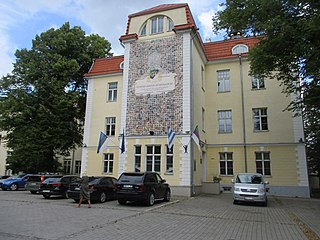
Gymnasium is a term in various European languages for a secondary school that prepares students for higher education at a university. It is comparable to the US English term preparatory high school or the British term grammar school. Before the 20th century, the gymnasium system was a widespread feature of educational systems throughout many European countries.

A secondary school or high school is an institution that provides secondary education. Some secondary schools provide both lower secondary education and upper secondary education, i.e., both levels 2 and 3 of the ISCED scale, but these can also be provided in separate schools. There may be other variations in the provision: for example, children in Australia, Hong Kong, and Spain change from the primary to secondary systems a year later at the age of 12, with the ISCED's first year of lower secondary being the last year of primary provision.

Buxtehude, officially the Hanseatic City of Buxtehude, is a town on the Este River in Northern Germany, belonging to the district of Stade in Lower Saxony. It is part of the Hamburg Metropolitan Region and attached to the city's S-Bahn rapid transit network. Buxtehude is a medium-sized town and the second largest municipality in the Stade district. It lies on the southern border of the Altes Land in close proximity to the city-state of Hamburg. To the west lie the towns of Horneburg and Stade and to the south there are a number of incorporated villages featuring mostly upscale housing; e.g., Ottensen and Apensen.

is a municipality ('Einheitsgemeinde') in the district of Harburg, in Lower Saxony, Germany. It changed its name on December 11, 1964 from ″Wulmstorf″ to ″Neu Wulmstorf″. It is part of the Hamburg Metropolitan Region.

The liceo classico or ginnasio is the oldest public secondary school type in Italy. Its educational curriculum spans over five years, when students are generally about 14 to 19 years of age.

Ruschwedel is a railway station in northwestern Germany. It is owned and operated by EVB, with regular trains on the line between Bremerhaven and Buxtehude.
The Wieland-Gymnasium is one of two Gymnasien in Biberach an der Riß, Baden-Württemberg, Germany. It is named after the poet Christoph Martin Wieland, who lived and worked in Biberach. The school is popular for introducing the Biberacher Modell, a model in which pupils begin to learn Latin at an early age, which has been adopted by many schools in Baden-Württemberg. At the moment the school counts 1029 pupils and 80 teachers. Since 2006, some new buildings, including a cafeteria, have been built on the school grounds to make the school ready for full-time classes.

The Zabergäu-Gymnasium Brackenheim is a general-education grammar school in Brackenheim, Germany. It is attended by about 1000 students from all over Zabergäu and its tradition goes back to the 15th century.

Shipman is a hamlet in the Canadian province of Saskatchewan.

VI High School – King Sigismund Augustus is a secondary school in the Bojary district of the city of Białystok in Poland.
Böstlingen was a village in the old district (Altkreis) of Fallingbostel, located in the Heidmark in the north German state of Lower Saxony. In 1935/36 it was abandoned because the German Wehrmacht wanted to establish a major military training area, the Truppenübungsplatz Bergen on the heath and forest of the Heidmark. The inhabitants were forcibly resettled.

The Gustav Adolf Grammar School is a secondary school in Tallinn, Estonia. Swedish king Gustavus Adolphus established it as the Reval Gymnasium in 1631. It is one of the oldest extant secondary schools in Europe.

The 3rd Armoured Division was formed on 2 July 1956 in Hamburg and was one of the first major formations of the new German Army or Bundeswehr after the Second World War. The 3rd Armoured Division was stationed on the North German Plain between the rivers Elbe and Weser. Its last headquarters location was Buxtehude. It was part of the I Corps alongside the 1st Panzer, 7th Panzer, and 11th Panzergrenadier Divisions.

The Gymnasium Schwertstraße in Solingen, North Rhine-Westphalia, Germany was established on 15 October 1841 as the Höhere Bürgerschule, and is the oldest and most traditional of the four gymnasiums in the city.
The Zeven Geest, which is part of the Stade Geest, is an area of sandy terrain in the northeast of the German state of Lower Saxony. It is named after the town of Zeven.

St Catherine's Monastery in Bremen, Germany, was founded in 1253 by the Dominicans. Today traces of its existence remain in the area of the Katharinenstraße and Katharinenklosterhof in the old town.

The Deutsch-Französisches Gymnasium Hamburg(DFG) or Lycée Franco-Allemand Hambourg (LFA) is a public, French-German school in Hamburg, Germany. It is directly operated by the Agency for French Education Abroad (AEFE), an agency of the French government, and is a part of its network.
Hubbard is an unincorporated community in northwest Randolph County, Missouri.
This page is based on this
Wikipedia article Text is available under the
CC BY-SA 4.0 license; additional terms may apply.
Images, videos and audio are available under their respective licenses.
























